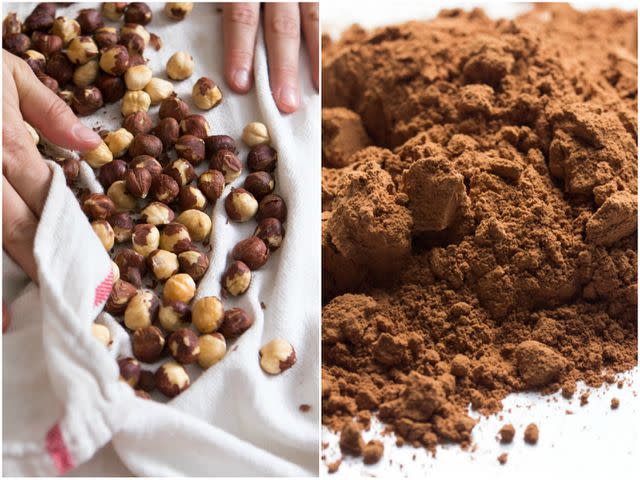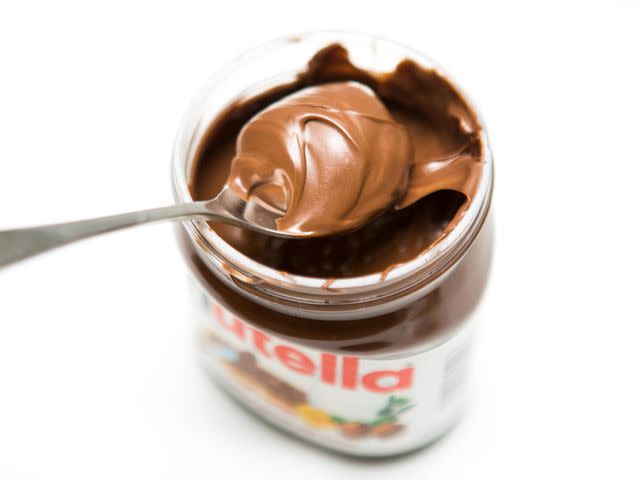From Napoleon to Nutella: The Birth of the Chocolate-Hazelnut Spread
The marriage of chocolate and hazelnut may seem as natural as bread and butter, but its origin story isn't nearly so simple.
Nutella's squat, oddly shaped jar has become a culinary icon across the globe, thanks to the compellingly rich and creamy chocolate-and-hazelnut spread housed within. But, while the marriage of chocolate and hazelnut may seem as natural as that of salt and pepper or bread and butter, its origin story isn't nearly so simple. It begins with the spread's progenitor, the chocolate-hazelnut treat called gianduia.*
*Also spelled "gianduja" at times. Both versions are pronounced "john-DOO-ya" and refer to the same product.

The Early History of Gianduia
The tale of gianduia's birth is often splashed across product labels and woven into pop history accounts of related products, including Nutella. In large part, that's because it's a compelling story—one of wartime desperation, economic strife, and the triumph of one industry's ingenuity. It starts in Turin, Italy, at the turn of the 19th century, and it's also almost certainly rife with untruths.
What most historians can agree on is that by the early 1800s, Turin had long held the distinction of being Europe's chocolate capital, its cacao-based products renowned as delicacies across the continent. But by 1806, its prominence was poised to collapse. Napoleon Bonaparte and his French Grande Armée were on the move, conquering Europe in the name of social enlightenment. Tensions between France and Britain had come to a head, culminating in a series of naval blockades and trade embargoes. In late fall, Napoleon enacted the Continental System, a sweeping blockade that halted all trade between the island kingdom and any country under the emperor's thumb, including the patchwork of kingdoms and city-states that would soon be unified under the name "Italy."
In the case of Turin, one particular change transformed its coveted chocolate industry. Britain, a dominant force in maritime trade, was a major vein in the flow of cacao between Mesoamerica and Europe; under the blockade, Turin found its main cacao source cut off.

Serious Eats / Vicky Wasik
From here, gianduia's origin myth gets a bit more complicated. Many claim that, unable to exploit Britain's access to cacao beans, Turin's chocolatiers needed a quick solution to supplement their supply and stay in business. The surrounding area of Piedmont, with its abundant hazelnut trees, proved to be just the ticket. When ground up, the hazelnuts took on the texture of cocoa powder, meaning that the nuts could be used to stretch what cocoa was available into a thick, ganache-like confection. In this version of the story, Turin's chocolatiers buoyed the local industry, harnessing their resourcefulness to create a brilliant new product—one that has persisted in popularity through the centuries.
As attractive as this narrative may be, there are reasons to call it into question. Some point out that at the time, chocolate was consumed in liquid form rather than in thick pastes or solid bars. Others argue that Turin chocolatiers would have lacked the powerful technology required to grind enough hazelnuts to make gianduia a cost-effective product on a large scale, let alone single-handedly save an entire industry.
While it's true that chocolate was first introduced to North America and Europe as a Mesoamerican medicinal beverage, and that the cacao press—the machine that made solid chocolate readily available—wasn't invented until 1828, there's ample evidence that so-called "eating chocolate" was established in Europe by the mid-17th century. In The True History of Chocolate, Michael and Sophie Coe point to instances of culinary experimentation with chocolate in Italy that date back to the 1680s, and records of "eating chocolate" from 18th-century France. The Marquis de Sade, known for his love of sweets, wrote to his wife from prison in the early 1800s, imploring her to send care packages filled with chocolate treats: "...half pound boxes of chocolate pastilles, large chocolate biscuits, vanilla pastilles au chocolat, and chocolat en tablettes d'ordinaire [chocolate bars]."
But just because chocolate was available in more than just liquid form doesn't mean that the Continental System resulted in the creation of gianduia, particularly given that virtually no primary sources link the two. More significant is the other oft-cited rebuttal to the legend**—the unlikelihood that technology available at the time could churn out enough of the new confection to save the Turin chocolatiers from the effects of their dwindling cacao supply.
** For an in-depth examination of the gianduia origin story, pay a visit to the blog DallasFood, which offers an impressive, thoroughly researched 34-part series.
If gianduia wasn't born out of necessity, then what was the catalyst for its creation? "My take on Turin and the whole kingdom of Savoy is that it was entirely under the sway of France in the 18th and 19th centuries," says Ken Albala, historian and director of the food studies program at the University of the Pacific in California. "I wouldn't be surprised if you find the combination [of chocolate and hazelnuts] in France before Italy." This influence makes sense, given Napoleon's conquest of the region, and suggests that gianduia was produced at a slow and gradually increasing rate, at least in its early years. It's likely that chocolatiers quietly released the chocolate-hazelnut blend, and that its growth in popularity was more of a slow boil than the explosion of success suggested by the prevailing narrative.
But, of course, a story that credits an invading force for a chocolate-confection-turned-regional-gem is not nearly as stirring as one that frames the chocolatiers as ingenious victors, who persevered in their trade in spite of the odds against them. And the motivation to reshape gianduia's narrative only grew with time.
From Puppet to Candy: Gianduia Gets a Name

Serious Eats / Vicky Wasik
By the mid-19th century, Italy was in the throes of the Risorgimento, the contentious, decades-long fight to unify the peninsula's states into a single kingdom. Italian nationalism was reaching a fever pitch, and revolutionary movement erupted across the soon-to-be nation. In Piedmont, which had seen an 1821 insurrection against its Austrian rulers, the atmosphere was uniquely ripe for patriotic myth-building. And it took the form of a character named Gianduia, a wine-guzzling, tricorn-hat-wearing, womanizing peasant.
Over the course of the 19th century, Gianduia had evolved from a traditional masked character in the Italian commedia dell'arte to a puppet, and then a pervasive political cartoon. His form was paraded across newspapers as a symbol of Turin, a jovial peasant mascot of sorts who represented the Piedmontese capital.
It was at the 1865 Turin Carnival, just four years after Italy's official unification, that Gianduia's name first became associated with the chocolate-hazelnut confection. There, candies said to resemble Gianduia's tricorn hat were distributed at the Carnival festivities, possibly by someone dressed as the character. Though a number of chocolate companies, most notably Caffarel, claim to have invented these confections, no evidence exists to verify their claims. What is more broadly agreed upon is that the chocolate-and-hazelnut sweets took on the name gianduiotti at roughly this point in time. Naming the candy for the city's most ubiquitous representative cemented it as a Turinese—and now, following unification, an Italian—creation. Gianduia has since become synonymous with the combination of chocolate and hazelnut, and variations on the name are used to refer to chocolates, spreads, and other confections.
War Strikes Again, and Nutella Is Born

Serious Eats / Vicky Wasik
After 90 years of producing their treats in relative peace, the chocolatiers of Turin faced a new period of uncertainty with the onset of World War II. As with Napoleon's blockade, the onset of the war brought with it food rations, and the supply of cocoa was once again drastically limited. In 1946, Piedmontese pastry chef Pietro Ferrero, inspired by gianduiotti and his chocolatier forefathers, created a thick paste using hazelnuts, sugar, and what little cocoa was available. He shaped the paste into a loaf and named it "Giandujot." But though its low proportion of expensive cocoa arose out of the cost-consciousness of the war years, Giandujot, so dense and thick that it had to be cut with a knife, was still too pricey for a mass audience.
In 1951, Ferrero revolutionized the industry with the first spreadable version of his sweet loaf: "La Supercrema." According to a BBC interview with Ferrero's grandson, Giovanni Ferrero, the spreadability of La Supercrema meant that "a small amount went a very long way, helping to break down the perception that chocolate was, as Giovanni puts it, 'only for very special occasions and celebrations like Christmas and Easter.'"
The availability and affordability of La Supercrema turned the chocolate-hazelnut spread into a household staple throughout Italy. In 1961, Ferrero's son, Michele, once again adjusted the recipe, adding palm oil and scaling it up for mass production. The new spread was rebranded as Nutella, and went on to become a common breakfast and snack item throughout Europe, touching down first in Asia and then the United States in the early 1980s. Nutella's world domination would surely have turned Napoleon green with envy.
It's rare that a jar of anything can embody two centuries of social, political, and historical change. But mixed with a touch of food lore under that white lid are Napoleon's bravado (possibly, at least); the ingenuity of the old Turinese chocolatiers; and the creativity of their descendant Ferrero. Creamy, nutty, and sweet, Nutella and its chocolate-hazelnut brethren are war, progress, and industrialization. Each spoonful snuck from the jar, every dollop that drips from the folds of a warm crepe, pays homage to the events that shaped its journey. And that's how it should be, because without those moments of strife and stress, our cupboards wouldn't be the same.
February 2017
Read More
Read the original article on Serious Eats.

